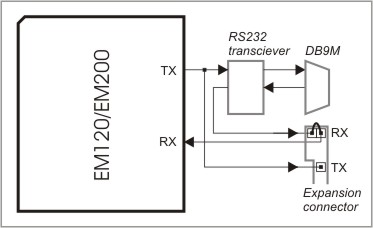Expansion Connector Pin Assignment
15-pin expansion connector has the following pin assignment:
P0 |
Connected to pin P0 of EM120/EM200 |
P1 |
Connected to pin P1 of EM120/EM200 |
P6 |
Connected to pin P6 of EM120/EM200 |
P7 |
Connected to pin P7 of EM120/EM200 |
P8 |
Connected to pin P8 of EM120/EM200 |
GND |
Ground |
VCC |
+5V from the EM120/EM200-EV board. Available "spare" current about 50mA |
RST |
Reset (active high) from the EM120/EM200-EV board. The signal is generated by an onboard reset IC. The same signal is applied to pin RST of EM120/EM200 |
MD |
Connected to the download/setup button on the EM120/EM200-EV board. The signal is connected to pin MD of EM120/EM200 |
DTR |
Connected to pin P3(DTR) of EM120/EM200 |
RTS |
Connected to pin P5(RTS) of EM120/EM200 |
TX |
Connected to pin TX of EM120/EM200 |
RX |
Connected to pin RX of EM120/EM200 |
CTS |
Connected to pin P4(CTS) of EM120/EM200 |
DSR |
Connected to pin P2(DSR) of EM120/EM200 |
Output signals that are present both on the DB9M and expansion connectors (DTR, RTS, TX) need not be switched. So, for example, the TX (output) line from the EM120/EM200 is connected to the RS232 transceiver IC and to the expansion connector. For input signals (RX, CTS, DSR) there must be a way to disconnect the RS232 transceiver IC from the EM120/EM200. Three jumpers (combined with pins RX, CTS, DSR of the expansion connector) serve this purpose.
For example, when the RX jumper is closed the RX pin of the EM120/EM200 receives a signal from the RS232 transceiver. When the jumper is opened you can use the RX pin on the expansion connector to supply a TTL RX signal from your own external board. Figure below illustrates this.

Maximum load for all CMOS-type lines (P0, P1, ... RX, TX...) is 10mA.